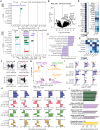Single-cell multiome and spatial profiling reveals pancreas cell type-specific gene regulatory programs of type 1 diabetes progression
- PMID: 40929272
- PMCID: PMC12422192
- DOI: 10.1126/sciadv.ady0080
Single-cell multiome and spatial profiling reveals pancreas cell type-specific gene regulatory programs of type 1 diabetes progression
Abstract
Cell type-specific regulatory programs that drive type 1 diabetes (T1D) in the pancreas are poorly understood. Here, we performed single-nucleus multiomics and spatial transcriptomics in up to 32 nondiabetic (ND), autoantibody-positive (AAB+), and T1D pancreas donors. Genomic profiles from 853,005 cells mapped to 12 pancreatic cell types, including multiple exocrine subtypes. β, Acinar, and other cell types, and related cellular niches, had altered abundance and gene activity in T1D progression, including distinct pathways altered in AAB+ compared to T1D. We identified epigenomic drivers of gene activity in T1D and AAB+ which, combined with genetic association, revealed causal pathways of T1D risk including antigen presentation in β cells. Last, single-cell and spatial profiles together revealed widespread changes in cell-cell signaling in T1D including signals affecting β cell regulation. Overall, these results revealed drivers of T1D in the pancreas, which form the basis for therapeutic targets for disease prevention.
Figures





Update of
-
Single-cell multiome and spatial profiling reveals pancreas cell type-specific gene regulatory programs driving type 1 diabetes progression.bioRxiv [Preprint]. 2025 Mar 17:2025.02.13.637721. doi: 10.1101/2025.02.13.637721. bioRxiv. 2025. Update in: Sci Adv. 2025 Sep 12;11(37):eady0080. doi: 10.1126/sciadv.ady0080. PMID: 40027657 Free PMC article. Updated. Preprint.
References
-
- Lehuen A., Diana J., Zaccone P., Cooke A., Immune cell crosstalk in type 1 diabetes. Nat. Rev. Immunol. 10, 501–513 (2010). - PubMed
-
- Boldison J., Wong F. S., Immune and pancreatic β cell interactions in type 1 diabetes. Trends Endocrinol. Metab. 27, 856–867 (2016). - PubMed
-
- Fasolino M., Schwartz G. W., Patil A. R., Mongia A., Golson M. L., Wang Y. J., Morgan A., Liu C., Schug J., Liu J., Wu M., Traum D., Kondo A., May C. L., Goldman N., Wang W., Feldman M., Moore J. H., Japp A. S., Betts M. R., HPAP Consortium, Naji A., Kaestner K. H., Vahedi G., Single-cell multi-omics analysis of human pancreatic islets reveals novel cellular states in type 1 diabetes. Nat. Metab. 4, 284–299 (2022). - PMC - PubMed
-
- Chiou J., Geusz R. J., Okino M.-L., Han J. Y., Miller M., Melton R., Beebe E., Benaglio P., Huang S., Korgaonkar K., Heller S., Kleger A., Preissl S., Gorkin D. U., Sander M., Gaulton K. J., Interpreting type 1 diabetes risk with genetics and single-cell epigenomics. Nature 594, 398–402 (2021). - PMC - PubMed

